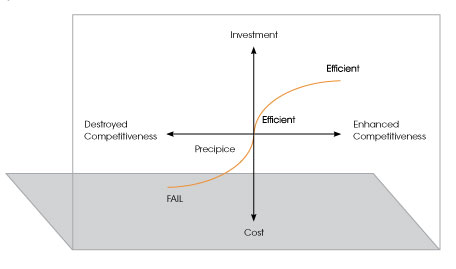Even healthy projects can take a turn for the worst if warning signs are ignored. But many times, project stakeholders aren’t even aware of problems until it’s too late. They miss the red flags simply because they don’t know about them; and when they do catch them, they don’t know how to respond. From that point on, project survival is touch-and-go.
Scenario planning is the process of building awareness of danger signs before a project commences, and developing rapid responses to be taken when the alarm bells sound. With proper scenario planning, you can keep your projects well away from life-threatening situations.
The 4 Scenarios
The core reasons that organisations embark on enterprise software projects is to improve their competitiveness and diminish limitations within the business. How successful they are depends largely on their ability to recognise and respond to project threats and weaknesses. Scenario planning is the ideal approach to this requirement.
Enterprise Software projects typically play out in one of four scenarios. These are depicted on the curved line in the graph below. The most desirable scenario is on the top right and the least desirable is bottom left of the graph.

Consider the 4 scenarios – fail, precipice, efficient and effective – and their consequences:
- The first and worst case scenario, the low road, is total project FAILURE. The project is cancelled and legal options are explored. Money, time, business opportunity and valuable staff are wasted, and confidence in Enterprise Software and business process optimization is broken. The company may even suffer irreparable destruction of its competitive positioning.
- In the second scenario, the project reaches a PRECIPICE. At this point of no return, it is less painful and costly to fund the flailing project to completion than return to the previous system. It is only partially
successful with few expected business benefits realised. Senior people may resign. Excessively long working days, accountability shifting and defensive posturing are the order of the day. The company loses competitive positioning and a difficult road lies ahead to rebuild lost opportunity. - Scenario three occurs when the project team claims an EFFICIENT project when measured against time and budget criteria. Changes were probably within palatable boundaries. The initial scope was doubtlessly reduced at some point to accommodate time and budget constraints. There is no
recognizable improvement in the business to the extent that the project could have been avoided. Meetings are strained and the future is filled with hard work to implement the next phases in attempts to redeem some business value from the investment. - The fourth and most desirable scenario, the high road, is an EFFECTIVE project where returns far outweigh the investment. Competitiveness has improved and limitations within the business have diminished. All business stakeholders embrace the way ahead and the future is exciting. Further enhancements to the business can usually be financed from the benefits achieved.
Notes
- Investment on the Y-axis of the graph. The more effective the project is in meeting business objectives, the greater the return on investment of money, time or other resources, and the more business value is gained.
- Cost on the Y-axis of the graph. The more the project fails to meet business objectives, the greater the cost, especially in terms of loss of the original investment, opportunity costs, or extra expenses to keep the project alive. Business value may also diminish.
- Competitiveness destruction on the X-axis of the graph. The company is less able to compete effectively in its chosen market. It loses market share and the cost of doing business increases. In a worst case scenario, the company closes down.
- Competitiveness enhancement on the X-axis of the graph. Competitive advantage is enhanced, enabling the company to stay ahead of present or potential competition. It gains flexible processes and systems, and is able to adapt rapidly to changing market trends.
Onpro Scenario Planning
Projects do not exist in isolation but are affected by factors over which the company executive and project team may or may not have control. Scenario planning and flag monitoring are the first line of defence against any adverse conditions or incidents that could endanger project success.
Onpro Consulting offers scenario planning with the flexibility for rapid change and monitoring as part of our project preparation and oversight service. It is offered to both company executives and the project steering committee, and includes:
- Scenario planning workshops with the company executive and project steering committee to:
- identify and agree the low and high road scenarios applicable to the planned project within the ambit of the company;
- identify the events both inside and outside of your control that could have a major impact on the success of the project;
- identify flags that will indicate when a specific scenario is playing out;
- prepare contingency plans for each identified event or indicator flag.
- An oversight service to
- assist with the independent monitoring of events and flags (independent, objective monitoring is important as some events and flags could be attributed to the project steering committee and project team);
- recognize and communicate the flags when they present themselves; and
- assist the company executive and project steering committee to enact the appropriate contingency plan when an event occurs or flags are raised.
The Safety of Your Project
Your project could be blindsided by a sudden, unexpected threat – one you never thought to plan for and have no response to. Thorough scenario planning acts as both an early warning system and a defence mechanism that will shield your healthy project from harm.
But scenario planning is technical and must be executed correctly to be effective. With Onpro Consulting at your side, you’ll not only achieve the highest quality of scenario planning; you’ll also gain an honest, ethical business partner whose objectivity could save you from your own blind spots.
